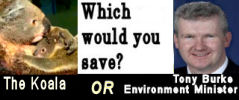Overdevelopment pushes koala closer to extinction - What is Environment Minister Tony Burke doing about this?
 "Minister Burke has ruled out protection for all koalas and we are concerned these northwest NSW koala populations may be left off the threatened species list, even while their populations are falling dangerously low." Zoologist David Paull: 75 per cent decline in the relative abundance of koalas in the Pilliga from 1993 to 2011. Estimates only 500 to 2000 koalas left in the area. “The spread of mines and gas wells, tree kills from coal seam gas spills and increased vehicles through the Pilliga Forest will likely put extra strain on these already declining koala populations." Wilderness Society, 29 April 2012.(This article elevates to an article a comment "Media Release - The Wilderness Society on Koalas," posted by Bandicoot on April 29-2012.)
"Minister Burke has ruled out protection for all koalas and we are concerned these northwest NSW koala populations may be left off the threatened species list, even while their populations are falling dangerously low." Zoologist David Paull: 75 per cent decline in the relative abundance of koalas in the Pilliga from 1993 to 2011. Estimates only 500 to 2000 koalas left in the area. “The spread of mines and gas wells, tree kills from coal seam gas spills and increased vehicles through the Pilliga Forest will likely put extra strain on these already declining koala populations." Wilderness Society, 29 April 2012.(This article elevates to an article a comment "Media Release - The Wilderness Society on Koalas," posted by Bandicoot on April 29-2012.)

Koalas must be included on the national threatened species list as part of Environment Minister Tony Burke's 30 April announcement, especially in NSW’s Gunnedah region and the Pilliga Forest where they face the additional threat of expanding coal mining and coal seam gas operations, according to the Wilderness Society.
“Koalas need to be protected across Australia as they are rapidly declining in numbers, especially in the Pilliga Forest, where three- quarters of the population has been wiped since 2000,” Naomi Hogan of the Wilderness Society said today.
"Minister Burke has ruled out protection for all koalas and we are concerned these northwest NSW koala populations may be left off the threatened species list, even while their populations are falling dangerously low.
“Gunnedah is known as the ‘Koala Capital of the World’, yet recent scientific studies show koala numbers across the region and in the nearby Pilliga Forest are seriously declining.”
Zoologist David Paull has recorded a 75 per cent decline in the relative abundance of koalas in the Pilliga from 1993 to 2011. He said the population was relatively stable until 2000 and estimates there are only 500 to 2000 koalas left in the area.
“In 1993 I would take tours through the Pilliga and we would always see koalas, the river banks would be teeming with female koalas with babies on their backs,” said zoologist David Paull, an associate of the University of New England. “Now, you are lucky to see them.”
Miss Hogan continued: “These northwest NSW koala hotspots are the target of very rapid and aggressive coal seam gas and coal mining expansion. The Pilliga Forest is covered by a proposal for the largest coal seam gas field in NSW, while the Liverpool Plains are threatened
by coal seam gas pilot wells at Spring Ridge and Marys Mount. Koalas in Leard State Forest are facing three enormous open-cut coal mines.
“The spread of mines and gas wells, tree kills from coal seam gas spills and increased vehicles through the Pilliga Forest will likely put extra strain on these already declining koala populations.
“The 2011 Senate Inquiry into koalas recognised the major threats to Koalas are habitat degradation, vehicle strikes and fire – all of which are likely to increase in the Pilliga Forest, Liverpool Plains and Gunnedah areas if coal seam gas mining proceeds.
“Koalas are an Australian icon that deserves Federal protection.” Contact Naomi Hogan, The Wilderness Society Newcastle: 0401 650 411
David Paull, Zoologist in the Pilliga Forest: 0424 252 244
Prue Bodsworth, The Wilderness Society Newcastle: 0427 417 870
PS: Tony Burke wants to exclude the latest modern threat to koala's from an overall protective status, yet they are a national, world-wide recognizable native animal? The Koala Capital's exclusion for coal seam mining would make mockery of any threatened status!
Partial Source: Media Release -The Wilderness Society on Koalas
On April 29th, 2012
Three-quarter of Koala population wiped out

Recent comments